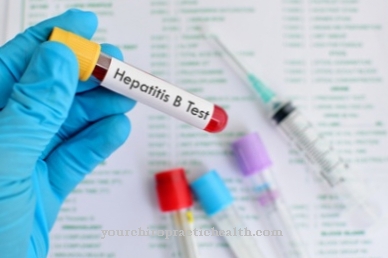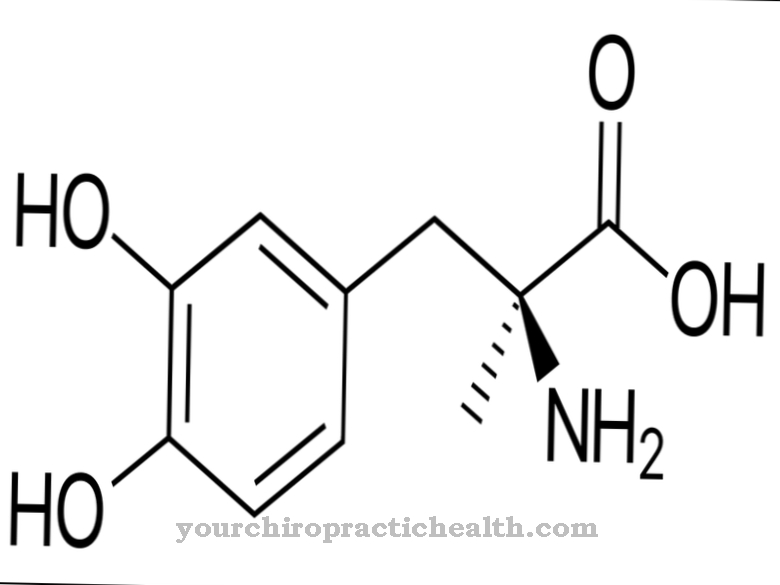Gemfibrozil is a medicinal substance that is one of the so-called fibrates. As such, gemfibrozil is given to treat diseases and disorders of lipid metabolism. In addition, it can also be taken for dietary purposes. This enables weight loss to be achieved.
What is gemfibrozil?
Gemfibrozil is a fibrate that is taken orally. The term fibrate summarizes various active ingredients in human medicine that are used to treat greatly increased cholesterol and triglycerol levels in the blood (hyperlipoproteinemia, or HLP for short).
Gemfibrozil is therefore indicated above all in diseases and disorders of lipid metabolism. By awarding it, the cholesterol levels, vascular deposits and blood lipid levels can be reduced considerably. It is also possible by taking Gemfibrozil to reduce the risk of vasoconstriction and to slow down constrictions that are already taking place.
The medicinal substance is described in chemistry and pharmacology by the empirical formula C 15 - H 22 - O 3, which corresponds to a moral mass of 250.34 g / mol. The white, waxy and crystalline powder is processed into film-coated tablets that the patient takes independently. These are sold under the trade name Gevilon®.
Pharmacological effect on the body and organs
Gemfibrozil works through activity at the receptor level. This is where the human body's fat metabolism is affected. This leads to a connection to the so-called peroxisome proliferator activated receptor (PPARα for short). This connection causes a synthesis of lipoprotein lipases from triglycerides. Lipases are water-soluble enzymes that break ester bonds in neutral fat. Lipoprotein lipases are able to break down the lipoproteins found in the blood, which prepares them for cellular uptake.
Due to the synthesis of lipoprotein lipases and triglycerides brought about by gemfibrozil, there is a decrease in the triglyceride content in the blood. In addition, the VLDL and LDL values are also reduced. LDL cholesterol increases the risk of a stroke or heart attack. It is described in the literature that gemfibrozil lowers the LDL level between 10% and 20%. The moderate level of HDL, on the other hand, should be able to be increased by between 5% and 20%.
Medical application & use for treatment & prevention
Gemfibrozil is used to postpone complementary treatments for lipid metabolic diseases and disorders. Gemfibrozil is the second mainstay of therapy, alongside diet or other measures such as exercise. According to current therapeutic practice, however, gemfibrozil represents the last resort. The drug is therefore not the first choice.
Attempts must or should be made in advance to treat the lipid metabolism in a different way. A change in diet, sufficient exercise and weight loss can be considered. In addition, it must be checked whether the patient cannot be successfully treated beforehand with drugs from the group of statins.
As described in the literature, it has been proven that taking gemfibrozil can reduce the risk of heart attack and the likelihood of coronary artery disease. Gemfibrozil is currently indicated primarily for type III hyperlipidemia or type IV hypertriglyceridemia.
Gemfibrozil is subject to pharmacy and prescription requirements in Germany and other countries of the European Union. The active ingredient is only available in pharmacies and must not be given out without a doctor's certificate. When taking it, it is essential to follow the doctor's instructions.
Risks & side effects
Since Gemfibrozil is an effective drug, it does not remain completely risk-free in taking it. Pay attention to contraindications and side effects.
A contraindication exists if the taking of gemfibrozil does not bring about the desired effects from a medical point of view, but leads to strong risks.There is also talk of a contraindication. In these cases, the intake or administration must be avoided. Gemfibrozil is contraindicated in people who are allergic or hypersensitive to gemfibrozil or other representatives of the fibrate group.
Even with acute functional disorders of the liver or kidneys, it must not be taken. This also applies to pregnant women, as the effects on unborn life are not yet fully understood.
In addition, interactions with other drugs must be considered. These can mainly occur with drugs that lower blood sugar such as repaglinide or statin. The attending physicians must be informed.
Furthermore, undesirable side effects are possible as part of the treatment. However, this is not mandatory. So far, it has been possible to establish a connection between the consumption of gemfibrozil and the formation of gallstones. Other side effects include an increased risk of cancer, hypokalaemia, or rhabdomyolysis. The latter is mainly noticeable through severe, suddenly occurring muscle pain.
In addition, the patient's blood count and fat levels must be checked during the treatment period. An examination of the liver values may also be necessary.
Gemfibrozil also affects the ability to drive. After taking it, you may not take part in road traffic. The operation of heavy machines or devices must also be avoided.



























